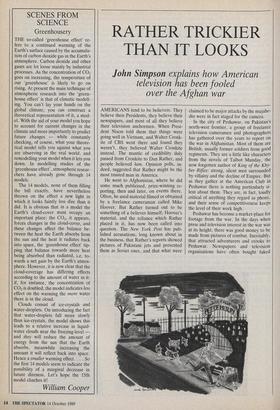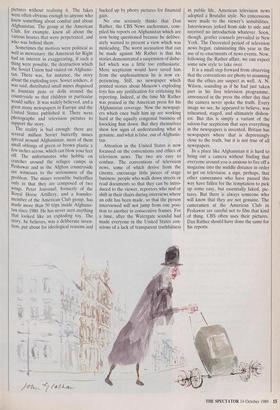RATHER TRICKIER THAN IT LOOKS
John Simpson explains how American
television has been fooled over the Afghan war
AMERICANS tend to be believers. They believe their Presidents, they believe their newspapers, and most of all they believe their television anchormen. When Presi- dent Nixon told them that things were going well in Vietnam, and Walter Cronk- ite of CBS went there and found they weren't, they believed Walter Cronkite instead. The mantle of credibility duly passed from Cronkite to Dan Rather, and people believed him. Opinion polls, in- deed, suggested that Rather might be thee most trusted man in America.
He went to Afghanistan, where he did some much publicised, prize-winning re- porting, then and later, on events there. Often, he used material filmed or obtained by a freelance cameraman called Mike Hoover. But Rather turned out to be something of a believer himself; Hoover's material, and the reliance which Rather placed in it, has now been called into question. The New York Post has pub- lished accusations, long known about in the business, that Rather's reports showed pictures of Pakistani jets and presented them as Soviet ones, and that what were claimed to be major attacks by the mujahe- din were in fact staged for the camera.
In the city of Peshawar, on Pakistan's north-west frontier, a group of freelance television cameramen and photographers has gathered over the years to report on the war in Afghanistan. Most of them arc British, usually former soldiers from good regiments. They are a little like characters from the novels of Talbot Munday, the now forgotten author of King of the Khy- ber Rifles: strong, silent men surrounded by villainy and the decline of Empire. But as they gather at the American Club in Peshawar there is nothing particularly si- lent about them. They are, in fact, loudly critical of anything they regard as phony, and their sense of competitiveness keeps the level of their work high.
Peshawar has become a market-place for footage from the war. In the days when press and television interest in the war was at its height, there was good money to be made from pictures of combat. Inevitably, that attracted adventurers and crooks to Peshawar. Newspapers and television organisations have often bought faked pictures without realising it. The fakes were often obvious enough to anyone who knew something about combat and about Afghanistan. The group at the American Club, for example, knew all about the various hoaxes that were perpetrated, and who was behind them.
Sometimes the motives were political as well as mercenary: the American far Right had an interest in exaggerating, if such a thing were possible, the destruction which the Soviet Union had visited on Afghanis- tan. There was, for instance, the story about the exploding toys. Soviet soldiers, it was said, distributed small mines disguised as fountain pens or dolls around the countryside so that children in particular would suffer. It was widely believed, and a great many newspapers in Europe and the United States published it. There were photographs and television pictures to support the story. The reality is bad enough: there are several million Soviet butterfly mines spread around Afghanistan, most of them small oblongs of green or brown plastic a few inches across, which can blow your feet off. The unfortunates who hobble on crutches around the refugee camps in Peshawar and in the Afghan countryside are witnesses to the seriousness of the problem. The mines resemble butterflies only in that they are composed of two wings. Peter Jouvenal, formerly of the Royal Horse Artillery, and a founder- member of the American Club group, has made more than 50 trips inside Afghanis- tan since 1980. He has never seen anything that looked like an exploding toy. The story, he believes, was a deliberate inven- tion, put about for ideological reasons and backed up by phony pictures for financial gain.
No one seriously thinks that Dan Rather, the CBS News anchorman, com- piled his reports on Afghanistan which are now being questioned because he deliber- ately wanted to present a view which was misleading. The worst accusation that can be made against Mr Rather is that his stories demonstrated a suspension of disbe- lief which was a little too enthusiastic. More scepticism would have saved him from the unpleasantness he is now ex- periencing. Still, no newspaper which printed stories about Moscow's exploding toys has any justification for criticising his reporting. Indeed, at the time Mr Rather was praised in the American press for his Afghanistan coverage. Now the newspap- ers which once built him up are working hard at the equally congenial business of knocking him down. But they themselves show few signs of understanding what is genuine, and what is false, out of Afghanis- tan.
Attention in the United States is now focussed on the conventions and ethics of television news. The two are easy to confuse. The conventions of television news, some of which derive from the cinema, encourage little pieces of stage business: people who walk down streets or read documents so that they can be intro- duced to the viewer, reporters who nod or shift in their chairs during interviews where an edit has been made, so that the person interviewed will not jump from one posi- tion to another in consecutive frames. For a time, after the Watergate scandal had made everyone in the United States con- scious of a lack of transparent truthfulness in public life, American television news adopted a Brutalist style. No concessions were made to the viewer's sensibilities. Interviewees jerked from side to side and received no introduction whatever. Soon, though, gentler counsels prevailed in New York. The Decorated period of television news began, culminating this year in the use of re-enactments of news events. Now, following the Rather affair, we can expect some new style to take over.
It is a small step forward from observing that the conventions are phony to assuming that the ethics are suspect as well. A. N. Wilson, sounding as if he had just taken part in his first television programme, announced in the press the other day that the camera never spoke the truth. Every image we see, he appeared to believe, was rehearsed, staged, and ultimately dishon- est. But this is simply a variant of the saloon-bar scepticism that says everything in the newspapers is invented. Britain has newspapers where that is depressingly close to the truth, but it is not true of all newspapers.
In a place like Afghanistan it is hard to bring out a camera without finding that everyone around you is anxious to fire off a magazine into the middle distance in order to get on television: a sign, perhaps, that other cameramen who have passed this way have fallen for the temptation to pick up some easy, but essentially faked, pic- tures. But there is always someone who will know that they are not genuine. The cameramen at the American Club in Peshawar are careful not to film that kind of thing. CBS often uses their pictures. Dan Rather should have done the same for his reports.



























































 Previous page
Previous page